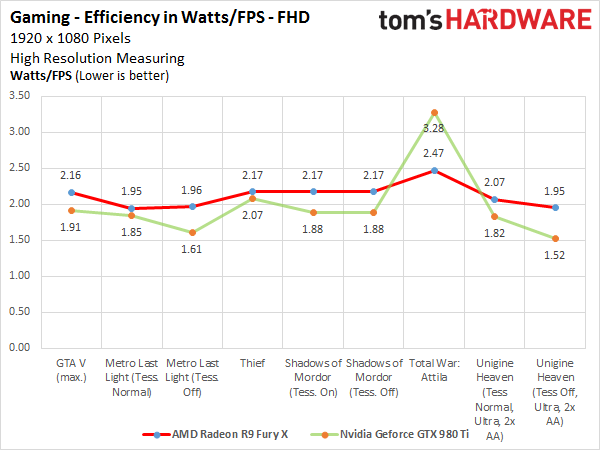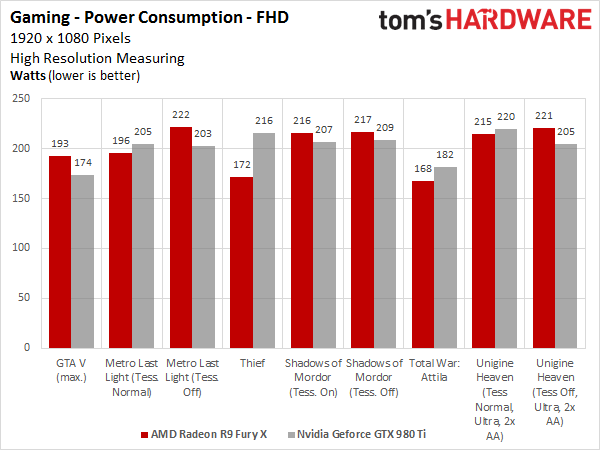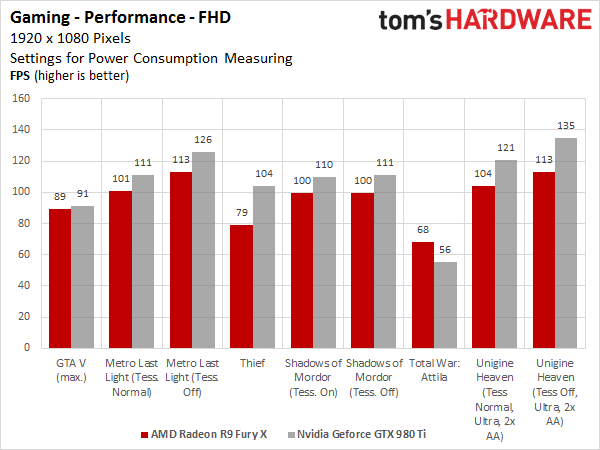AMD Radeon R9 Fury X Power And Pump Analysis
While AMD introduced its highly anticipated Radeon R9 Fury X in June, we’re taking a deeper look at its power consumption and pump noise.
Gaming @ 1920x1080 (FHD)
We know from AMD Radeon R9 Fury X 4GB Review that the Fury X doesn't do as well as many enthusiasts would have hoped compared to Nvidia's GeForce GTX 980 Ti. The averages of all of our results are very similar. At first glance, AMD’s 202W result doesn't look any worse than Nvidia's outcome (incidentally, also 202W). If gaming performance per watt is taken into account, though, then there’s a gap in Nvidia’s favor. But this doesn’t tell the whole story.



Flipping through the graphs, the individual results for power consumption (chart two) and the corresponding benchmarks (chart three) stick out. The insight gained from their comparison is quite simple: the reason that power consumption isn’t higher is that the graphics card limits it. This effect is particularly pronounced if the game involves tessellation. Metro: Last Light shows very clearly that tessellation is the Radeon R9 Fury X’s primary performance killer. What’s even more shocking is that Fiji's power consumption jumps way up with tessellation, whereas GM200 isn't as affected.
Get Tom's Hardware's best news and in-depth reviews, straight to your inbox.

Igor Wallossek wrote a wide variety of hardware articles for Tom's Hardware, with a strong focus on technical analysis and in-depth reviews. His contributions have spanned a broad spectrum of PC components, including GPUs, CPUs, workstations, and PC builds. His insightful articles provide readers with detailed knowledge to make informed decisions in the ever-evolving tech landscape
-
Cryio I'm seriously curious to see what 2015's Omega Driver does to Fury X's efficiency and overall performance.Reply -
thor220 More pages are spent on the whine then the actual performance of the card. It's an issue that's already been addressed, tom's really didn't have to dedicate so much to such a small issue.Reply
Comparatively, at least it doesn't reduce performance like the last 0.5 GB on the 970, and I don't remember tom's being on Nvidia's case about that much more serious issue. -
i7Baby The ISO standard is more about making sure you settle on a quality standard and stick to it rather than improving quality. You can get certification by having a system in place that churns out crap - systematically.Reply
Somehow I don't think a lot of PC stuff is rigorously specified. In this case I think samples were signed off by sales and marketing. This is how much of the PC industry is run. -
crisan_tiberiu With AMD, many users are going to be using first time in their PC a liquid cooler, so many wont have previous experiences to compare and they just gonna say that the sound is normal. These sound issues i am sure that they were known issues i am sure of it. Still, i would buy the Fury, i am sure that the tiny pump on the card has less than 0 chance on beating in noise levels my aquarium pumps that sit next to my desktop PC (i have 1 air pump and 1 filter motor..., so yeah i know what loud means) :D :D :DReply -
hannibal http://forums.anandtech.com/showpost.php?p=37527347&postcount=43Reply
They are really changing the pump. Someone tried to upper their margins by cutting quality. But all in all even the older pump is very quiet and with the right version situation gets even better.
The FuryX is very good card. Luckily so is 980ti even in bigger measurements! Interesting to see how air coolet Fury will change the situation. All in all 980ti will make FuryX cheaper and FuryX forced the Nvidia to make something else than TitanX to customers. Competition is good!
980ti is very good card and FuryX allmost gets there. Because of AMD problems with DX11 the situation may be reversed in DX12 games so in longer run the situation is even as it should be for the customers.
Hopefully we will soon see some retake when Toms will get the upgraded pump to the test. Also it seem that some parts that are not water cooled can get quite hot, so Air cooled basic Fury will be very interesting card to be get tested.
The situation in GPU part is better than for long times! The next year will be even more interesting, because we may see first finvet based GPUs and also second generation of HBM.
-
FormatC Reply16185600 said:More pages are spent on the whine then the actual performance of the card. It's an issue that's already been addressed, tom's really didn't have to dedicate so much to such a small issue.
Comparatively, at least it doesn't reduce performance like the last 0.5 GB on the 970, and I don't remember tom's being on Nvidia's case about that much more serious issue.
This is a follow-up, not the launch review. In the first part of this follow-up with power consumption measuring I have tested both cards in a lot of games and applications - together with the specific power draw for each card in each benchmark. This is more than other sites published. 10,240,000 single values - this wasn't done in a few hours.
Simply use the slider pics to compare power consumtion, performance and watts/fps. :)
I don't remember tom's being on Nvidia's case about that much more serious issue
This is only one example:
http://www.tomshardware.com/news/MSI-GTX-660-670-overvolting-PowerEdition,18013.html
(the original, detailled review was in German)
-
synphul It's unfortunate that they continue to slap the cheapy aio pump combos on everything. Rather than improving it sounds like quality just keeps dropping. Stating that the fan is so noisy it will probably drown out the annoying budget pump isn't really much consolation. In addition to performance charts, notations like these are important in a review. If a product has undesirable quirks it would be much nicer to know before dropping close to $700 on it. If this was a $200-300 card it might be more tolerable, not at those prices though. People paying top dollar should receive top quality. I'd rather they charge $10 more and do it right. Especially considering aio's have been around long enough they're no longer in their quirky 'infant' stage.Reply -
Mousemonkey Reply16185733 said:http://forums.anandtech.com/showpost.php?p=37527347&postcount=43
They are really changing the pump. Someone tried to upper their margins by cutting quality. But all in all even the older pump is very quiet and with the right version situation gets even better.
The FuryX is very good card. Luckily so is 980ti even in bigger measurements! Interesting to see how air coolet Fury will change the situation. All in all 980ti will make FuryX cheaper and FuryX forced the Nvidia to make something else than TitanX to customers. Competition is good!
980ti is very good card and FuryX allmost gets there. Because of AMD problems with DX11 the situation may be reversed in DX12 games so in longer run the situation is even as it should be for the customers.
Hopefully we will soon see some retake when Toms will get the upgraded pump to the test. Also it seem that some parts that are not water cooled can get quite hot, so Air cooled basic Fury will be very interesting card to be get tested.
The situation in GPU part is better than for long times! The next year will be even more interesting, because we may see first finvet based GPUs and also second generation of HBM.
Interesting that you see AMD somehow forcing Nvidia's hand, maybe Nvidia is just doing it's own thing and AMD are the one's playing catch up and having to release untested products in order to try and stay in the game. The GDDR5 bit is amusing enough as it indicates a design change that could explain why there was mention of the cards RAM using a fair bit of juice, it's also good to know that it can use Mantle but I didn't see mention of Freesync? -
Nuckles_56 My question is why Total War: Attila was causing such a spike in watts/fps on the 980ti?Reply